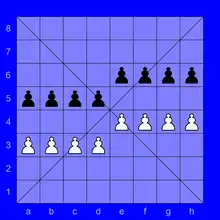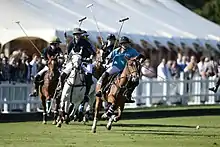Myanmar has a number of traditional games, sports, and martial arts.[1][2] Some of these games were designed to teach people how to protect themselves and their communities.[3]
Traditional games
Chinlone
Phankhon

Htote si toe
Htote si toe (meaning "border-crossing game") is a tag game in which offensive players attempt to cross the lines of a narrow field without being tagged by defenders standing on those lines.[6][7]
Gaung ohn yite
This is a game in which two opponents sit on a bar elevated above the ground and attempt to knock each other off by hitting one another with a pillow.[8][9]
Martial arts
Lethwei

Naban
Kyin
Kyin (Burmese: ကျင်) is a form of wrestling from Myanmar. It is practiced by the Rakhine people, a minority group in Myanmar. It is practiced in Rakhine State. Tournaments of this sport are usually held during big occasions, for example, Rakhine State Day events.
In Kyin wrestling tournaments, practitioners usually put on a display of warming-up dancing, which is called "kyin kwin" in their local language. Then the fighting is on. The rules are simple. No punching. No touching on the face. No attacking below the belt. The winner throws his opponent to the ground a fixed number of times.[23]
The walls near the cave of Shite-thaung Temple which was built in 1531 show early depiction of the sport of kyin wrestling.[24]Board games
Sittuyin

Sittuyin (Burmese: စစ်တုရင်), also known as Burmese chess, is a strategy board game created in Myanmar. It is a direct offspring of the Indian game of chaturanga, which arrived in Myanmar in the 8th century thus it is part of the same family of games such as chess, and shogi. Sit is the modern Burmese word for "army" or "war"; the word sittuyin can be translated as "representation of the four characteristics of army"—chariot, elephant, cavalry and infantry.
In its native land, the game has been largely overshadowed by Western (international) chess, although it remains popular in the northwest regions.[25]Animal events
Polo

Polo was popular among royals in Myanmar, as evidenced by historical illustrations.[1]
See also
References
- 1 2 May, San San (2018-07-26). "Chinlone, polo and more: Paintings from Burmese manuscripts show how traditional games were played". Scroll.in. Retrieved 2023-08-24.
- ↑ Downing, Jared (2018-09-01). "Traditional Myanmar street games explained". Frontier Myanmar. Retrieved 2023-08-24.
- ↑ Huh, Youn Jung; Lim, Boo Young; Im, Haesung (2022-01-02). "Myanmar children's play and resilience: analyses of Myanmar teacher candidates' digital photo essays". International Journal of Play. 11 (1): 81–98. doi:10.1080/21594937.2022.2042937. ISSN 2159-4937.
- ↑ Dir. Hamilton, Greg (2006). Mystic Ball. The film, Black Rice Productions.
- ↑ "The encyclopedia of Myanmar Games". Retrieved 2018-11-12.
- ↑ "Traditional sports event in Palaw marks 71st anniversary of Independence Day". MDN – Myanmar DigitalNews. Retrieved 2023-08-24.
- ↑ Sengupta, Nilanjana (2015-12-09). The Female Voice of Myanmar: Khin Myo Chit to Aung San Suu Kyi. Cambridge University Press. ISBN 978-1-316-57027-2.
- ↑ SST (2021-08-05). "Gallery: National Night Out celebrations around Johnson County". Southside Times. Retrieved 2023-08-24.
- ↑ "Traditional Games in Myanmar". study.com. Retrieved 2023-08-24.
- ↑ Kyaw Zin Hlaing (1 September 2015). "Easy win for Lethwei fighters". Myanmar Times.
- ↑ Karl R. De Mesa (12 March 2019). "The Most Brutal Sport in the World Uses Bare Knuckles and Head Butts". Vice.
- "Myanmar's Lethwei - the most brutal combat sport in the world?". Channel News Asia. 27 October 2019.
- James Rees (25 August 2022). "Is Lethwei The Most Brutal Martial Art?". Lethwei World.
- Ondřej Jarůšek (12 November 2022). "The Most Brutal Sport In The World: Burmese Boxing Is Only For The Strongest". Refresher.
- "Canadian Boxer's Action Turns Into A Big Issue". Thai News Room. 9 May 2021.
Burmese bare knuckle boxing, considered the world's most brutal sport
- ↑ Olavarria, Pedro (2 December 2014). "Bando: The style of Burmese Martial Arts". VICE Fightland.
- Calderon, Justin (23 September 2014). "Punches, headbutts, knockouts: Asia's 'new' martial arts sensation". CNN.
- 1 2 "Lethwei : The world's most brutal sport". Ugly Chicken. 4 October 2017. Archived from the original on 7 July 2019.
- ↑ Darren (18 April 2019). "Lethwei Fighter Lands Torpedo Headbutt KO". Scrap Digest. Retrieved 17 July 2020.
- ↑ Zarni Pyo (21 July 2017). "The Art Of Nine Limbs". Myanmar Times.
- ↑ Steven Rae (13 March 2019). "Lethwei: Everything you need to know about Burmese bareknuckle boxing". The Body Lock.
- ↑ Paul Millar (18 July 2018). "BAREKNUCKLE BOXING Blood sport". South East Asia Globe.
- Jack Board (27 October 2019). "From Myanmar, with blood: The Singaporean fighting tradition to take the martial art of lethwei to the world". Channel News Asia.
Lethwei is considered by some to be the world's most brutal martial art
- Matthew Scott (11 November 2017). "'Once you get a taste, there's no turning back': brutal, bloody lethwei making Myanmar a martial arts mecca". South China Morning Post.
- Jack Board (27 October 2019). "From Myanmar, with blood: The Singaporean fighting tradition to take the martial art of lethwei to the world". Channel News Asia.
- ↑ "THE ART OF THE NINTH LIMB: HOW THE HEADBUTT CHANGES A FIGHT". The Fight Library. December 20, 2023.
- ↑ Green, T. (2001). Martial Arts of the World An Encyclopedia (Vol. 1).
- ↑ Draeger, D. F., Smith, R. W. (1980). Comprehensive Asian Fighting Arts. Japan: Kodansha International.
- ↑ Green, T. (2001). Martial Arts of the World An Encyclopedia (Vol. 1).
- ↑ Donn F. Draeger and Robert W. Smith (1969). Comprehensive Asian Fighting Arts. Kodansha. ISBN 978-0-87011-436-6.
- ↑ "Rakhine traditional wrestling in Myanmar (by Coconuts TV)". Coconuts TV. 17 April 2017. Archived from the original on 2021-01-11. Retrieved 2020-12-31. Alt URL
- ↑ Kyun (Myanmar). (n.d.). Traditional Sports. https://www.traditionalsports.org/traditional-sports/asia/kyun-myanmar.html
- ↑ Pritchard (1994), p. 31
- ↑ "THE HISTORY OF POLO". argentinapolo.com.